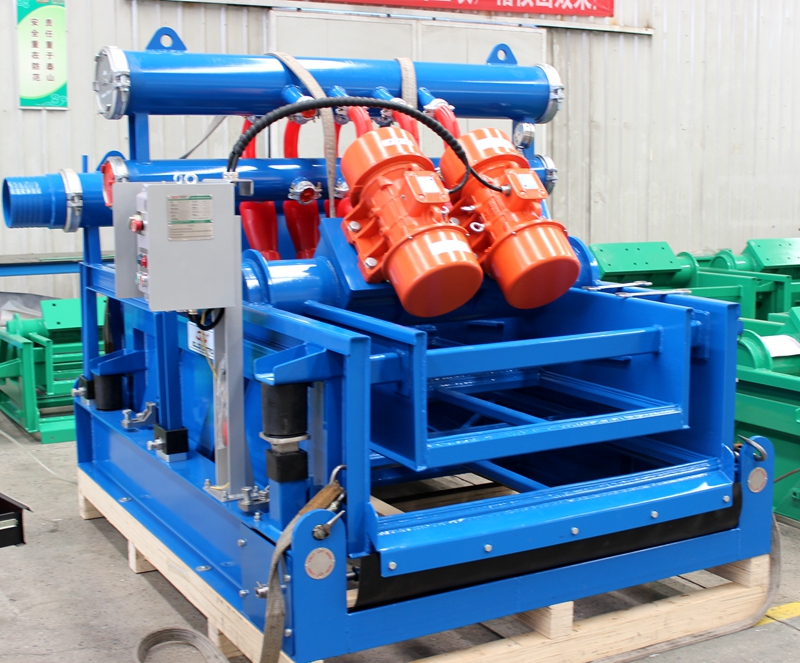
A full set of 350 GPM mud recycling system was dispatched from GN Solids Control’s factory 2 weeks ago. The customer buy HDD rig from America Augers, and buy the mud recycling system from GN Solids Control. GN Solids Control customized the same blue color to make the mud recycling with the same color as client’s rigs.
It is a compact design desanding and mud recycling system suits for HDD rigs, CBM drilling, water well drilling and other underground constructions. The 350 GPM mud recycling system is including following equipment:
1) 1 set of Mud Cleaner model GNZY705E-Y6N. It is C/W 5 pcs composite material screen offer for free by GN Solids Control. The mud cleaner is with a double deck shale shaker. The bottom deck can be used as shale shaker, while there is a desilter cone assembly mounted on the top of the upper deck. It can also be used as a mud cleaner.
2) 2 ea of Centrifugal pump 22kw. One pump is used as feeding pump for mud cleaner desilter unit. Another centrifugal pump will be used as mixing pump. It is a mechanical sealing centrifugal pump. The centrifugal pump casing and impeller are made from Wear-resistant material for longer lifetime. The whole pump and all its spare parts are interchangeable with Mission Magnum pump.
3) 1 ea mixing hopper GNSLS25A. The hopper will be used together with the mixing pump to work as a full mixing unit.
4) 1 ea Mud agitator and 1 ea mud gun will be used to avoid mud settle down at tank bottom.
5) A full set of Mud tank is equipped with Ladder, Gavalized slide walkway, handrail, Valves, mud pipe line, clean gate etc. The tank overall dimension is 6000×2100×1600mm. Total useful capacity of the mud tank is 10m3
6) GN offered turnkey solution to customers. A full set of Explosion Proof Electric Control System is equipped to control all the items and equipment within the mud recycling system.
GN Solids Control does offered customized solutions per clients’ request. For any inquires, you can contact GN Solids Control at This email address is being protected from spambots. You need JavaScript enabled to view it. .
- Details
-
Published: 29 January 2018
Chinese Lunar new year holiday is coming in the corner. There is only 3 weeks before the holiday. As there will be no people working during the holiday. And there is no vessel for shipment during a whole month. GN Solids Control workshop is working day and night to ensure a timely delivery before the new year holiday. This week, 3 sets of mud gas separator is ready for shipment and will be ship to a France client soon.
Application and functions of mud gas separator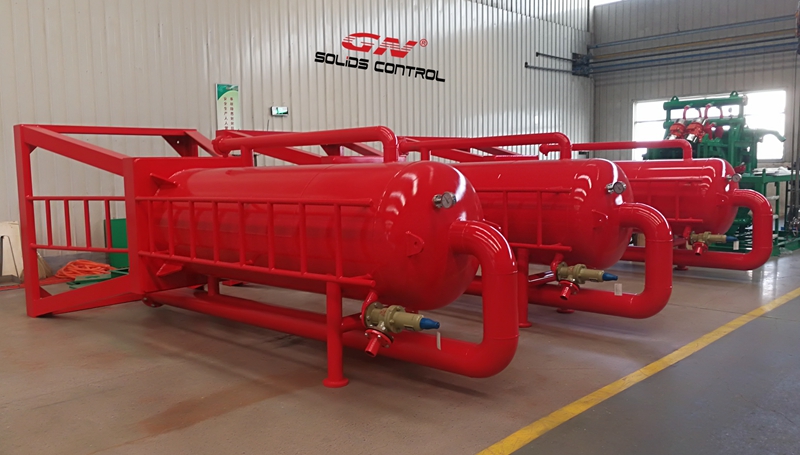
The mud gas separator is an effectively machine to prevent harmful gas from erosion, and ensure the safety of human and rig site equipment. It is also named poor boy degasser. When the drilling fluid is with air invasion, there will be a large deviation on drilling fluids proportion and viscosity, it cannot meet the drilling requirements. if the air invasion drilling fluids cannot be treated timely and properly, it will cause a surge, or even cause blowout accident. The combination of l mud gas separator and electronic ignition device can ensure the smooth operation of the drilling process.
The mud gas separator is used with choke manifolds to remove free gas from drilling fluids. And mud gas separator can be applied to underbalanced drilling and gas containing hydrogen sulfide. It is used to control liquid level and pressure of air invasion drilling fluids.
Besides mud gas separator, GN Solids Control offers complete solution on mud solids control and drilling waste management.
Mud solids control equipment GN Solids Control does offer:
Shale shaker, desander, desilter, mud cleaner, borate receovery decanter centrifuge, high speed decanter centrifuge, mud tank system, mud mixing system, mud agitator, various pumps etc…
Drill cuttings treatment equipment GN Solids Control does offer:
High speed and big bowl decanter centrifuge, vertical cuttings dryer, High G shale shaker, screw conveyor, dewatering unit, screw pumps, drill cuttings solidification unit, etc….
High quality replacement composite material pretension screens for different shaker models.
GN Solids Control advanced design equipment is with new technology. GN can offer Zero discharge drilling fluids treatment equipment for drilling rigs.
- Details
-
Published: 20 January 2018
Many clients showed interested in GN made high pressure vacuum pump for long distance solids, drilling cuttings and oily sludge transfer. But after they get quotation from GN Solids Control, they thought the pump is too expensive, or the transfer capacity is too small compared with their request.
That is because they do know the difference of the high pressure solids transfer vacuum pump with the normal slurry pump and screw pump. They want to use the high pressure solids and sludge transfer vacuum pump to transfer drilling mud from rig well head to mud system shale shaker, or they want to use the vacuum sludge transfer pump to replace slurry pump.
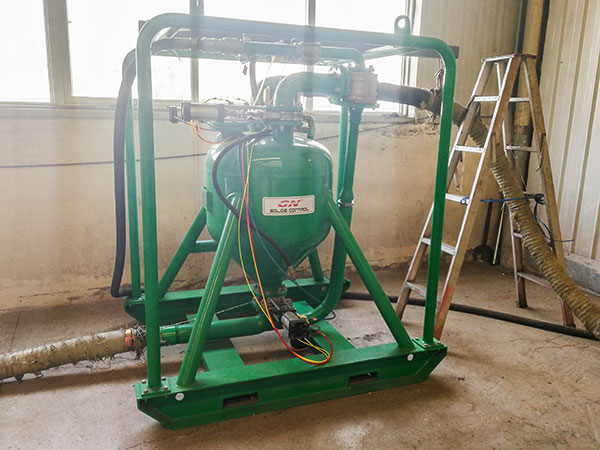
The vacuum pump is a special and powerful pump.It is used to transfer materials that other pumps cannot do, the job site that other pump cannot meet. Or the high pressure solids and sludge transfer vacuum pump can be used in hazardous environment. Like the big tank cleaning, deep pit suction, etc... If normally slurry pump, centrifugal pump and screw pump cannot do the job, clients can choose the solids and sludge transfer vacuum pump to do the job.
Features of Solids / Drilling cuttings / Oily sludge transfer Vacuum pump for long distance suction and transfer:
1) Sucking distance of the solids and sludge transfer vacuum pump can reach to 50 meter
2) Discharge distance of the solids and sludge transfer vacuum pump can maximum reach to 1000 meter.
3) The solids and sludge transfer vacuum pump can handles solids up to 75 mm (3â€)
4) As the vacuum pump is a fully air driven pump. The air consumption is big. Air consumption of the vacuum pump is 17m3/min (600 CFM) at 550Kpa-785Kpa (80-114PSI).
GNSP Sludge Vacuum Pump is a Pneumatic pump without any rotation items.
With special structure design and powerful suction capability, it can be used at tough environmental for solids transfer, high working performance and less maintenance.
Client can visit GN website to download the working video of the vacuum pump:http://www.gnsolidscontrol.com/video/gn-drilling-cuttings-or-sludge-vacuum-transfer-pump-working-video
Or visit GN website to check more Specifications of the pump: http://www.gnsolidscontrol.com/sludge-vacuum-pump
- Details
-
Published: 13 January 2018
Many clients showed interested in GN made high pressure vacuum pump for long distance solids, drilling cuttings and oily sludge transfer. But after they get quotation from GN Solids Control, they thought the pump is too expensive, or the transfer capacity is too small compared with their request.
That is because they do know the difference of the high pressure solids transfer vacuum pump with the normal slurry pump and screw pump. They want to use the high pressure solids and sludge transfer vacuum pump to transfer drilling mud from rig well head to mud system shale shaker, or they want to use the vacuum sludge transfer pump to replace slurry pump.

The vacuum pump is a special and powerful pump.It is used to transfer materials that other pumps cannot do, the job site that other pump cannot meet. Or the high pressure solids and sludge transfer vacuum pump can be used in hazardous environment. Like the big tank cleaning, deep pit suction, etc... If normally slurry pump, centrifugal pump and screw pump cannot do the job, clients can choose the solids and sludge transfer vacuum pump to do the job.
Features of Solids / Drilling cuttings / Oily sludge transfer Vacuum pump for long distance suction and transfer:
1) Sucking distance of the solids and sludge transfer vacuum pump can reach to 50 meter
2) Discharge distance of the solids and sludge transfer vacuum pump can maximum reach to 1000 meter.
3) The solids and sludge transfer vacuum pump can handles solids up to 75 mm (3â€)
4) As the vacuum pump is a fully air driven pump. The air consumption is big. Air consumption of the vacuum pump is 17m3/min (600 CFM) at 550Kpa-785Kpa (80-114PSI).
GNSP Sludge Vacuum Pump is a Pneumatic pump without any rotation items.
With special structure design and powerful suction capability, it can be used at tough environmental for solids transfer, high working performance and less maintenance.
Client can visit GN website to download the working video of the vacuum pump:http://www.gnsolidscontrol.com/video/gn-drilling-cuttings-or-sludge-vacuum-transfer-pump-working-video
Or visit GN website to check more Specifications of the pump: http://www.gnsolidscontrol.com/sludge-vacuum-pump
- Details
-
Published: 13 January 2018
2 sets of skid mounted Vertical Dryer for drying drill cutting is ready for shipment. The 2 sets cuttings drying package will be dispatched to clients next week. The cuttings dryring packages are including following processing equipment:
1.The Vertical cuttings Dryer;
2.High speed big bowl decanter centrifuge
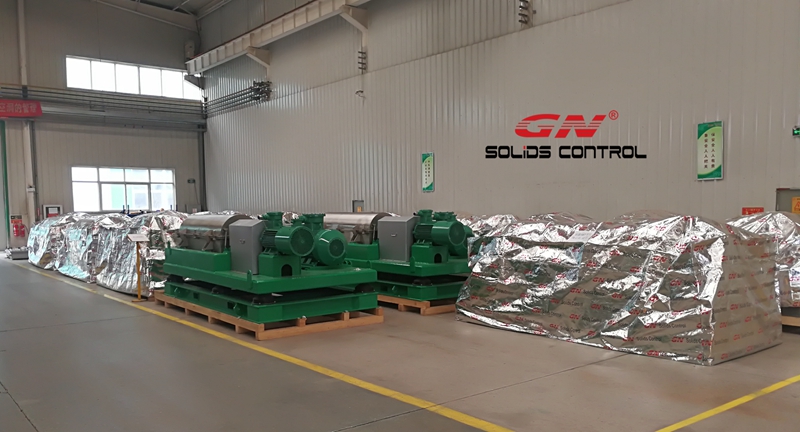
The skid mounted vertical cuttings dryer and centrifuge package is mainly used for OBM (oil based mud) and OBSM cuttings treatment.
The Vertical Cuttings Dryer uses centrifugal force to dry drilled solids in oil orsynthetic base fluids. It is used to recovery drilling fluids from the drilling cuttings. It can maximize the recycling of drilling fluids, and to minimize the drilling waste in order to save cost for operators.
The 2 sets decanter centrifuge are 18 inch big bowl centrifuge for low gravity solids separation. The liquid recovered from vertical cuttings dryer is weighted. The low gravity solids content is high. The weighted drilling fluids cannot be used directly for drilling. Decanter centrifuge will be used to remove the fine solids and reduce the mud weight. As decanter centrifuge can only remove particles above 2 ~ 5 microns. In some cases, the chemical dosing system will be used in order to further remove the ultrafine solids smaller than 2 ~ 5 microns. 14 inch centrifuge is a popular size for the separation. 18 inch centrifuge is used here for a bigger capacity.
Besides decanter centrifuge and Vertical cuttings dryer package, GN solids control offers other separation equipment for the drilling cuttings treatment and recovery.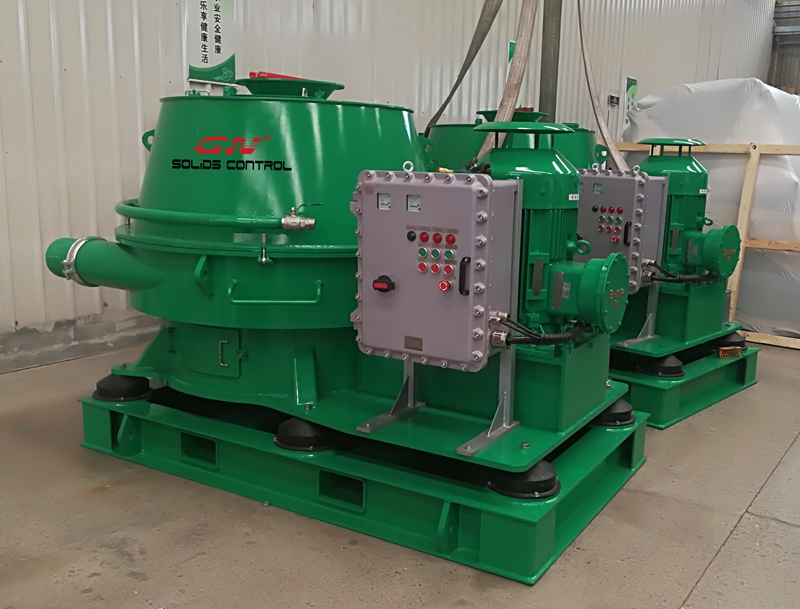
High G drying shale shaker is equipment normally mentioned and compared to vertical cuttings dryer. It is a kind of linear motion shale shaker utilizes high G force for the water based mud and cuttings separation. It can also be used as pre-separation of oily sludge separation system. In oily sludge separation system, big wire mesh screens will be used to remove the coarse solids. And sealing cover will be used to prevent the Volatile gas from the sludge. As the gas is harmful to human.
- Details
-
Published: 05 January 2018
The shale shaker screen from the original shaker manufacture Derrick Equipment company is metal frame shaker screen. To have a better quality shaker screen, GN Solids Control has developed new technology replacement shaker screen for Derrick FLC 500 series shale shaker.
The composite shaker screen is made by plastic injection, inside the frame is metal to support the shaker screen outside is covered by recyclable plastic.
The advantage of GN Composite shaker screen for Derrick FLC 500 are as following:
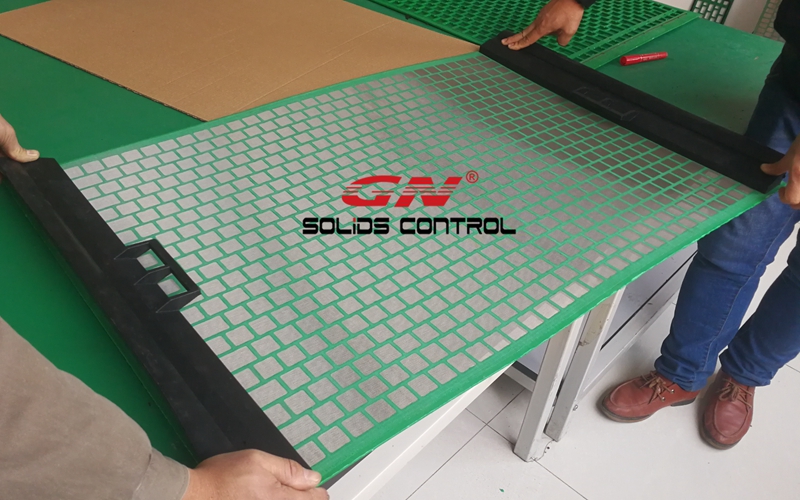
1)Inside metal frame is made by CNC machine have better quality and consistency.
2)High temperature resistant to 140 °C degree compared to metal frame shaker scree for HPHT drilling conditions.
3)Four-side tension of mesh during the heat press to minimize the gap between the top screen and support screens, in a result extending the screen life.
4)GN shaker screen for FLC 500 is made from high performance wire mesh configuration is compliant to API RP 13C with normally longer screen life.
5)The replacement shaker screen for FLC 500 is is repairable to save cost.
6)Since the replacement shaker screen is with composite frame which is covered by plastic, it is rust resistant for long time storage up to over 5 years.
Besides the composite frame shaker screen for Derrick FLC 500, GN shale shaker screens are available for many other types. Following are the popular shaker screens in composite frame from GN Solids Control:
1) Replacement Screen for NOV Brandt Cobra, King Cobra, Mini Cobra, Venom, LCM-2D, LCM-3D shaker, VSM 300 shale shaker.
2) Replacement Shaker Screen for MI-Swaco MONGOOSE PRO, MONGOOSE PT & MEERKAT, and MD-2/MD-3 shale shaker.
To make is easier for clients to select and order shale shaker screen from GN Solids Control. We have published our online shopping mall for shale shaker screen. Please visit: www.gnsolidsmall.com for more details and order your shaker screen online.
- Details
-
Published: 02 January 2018
